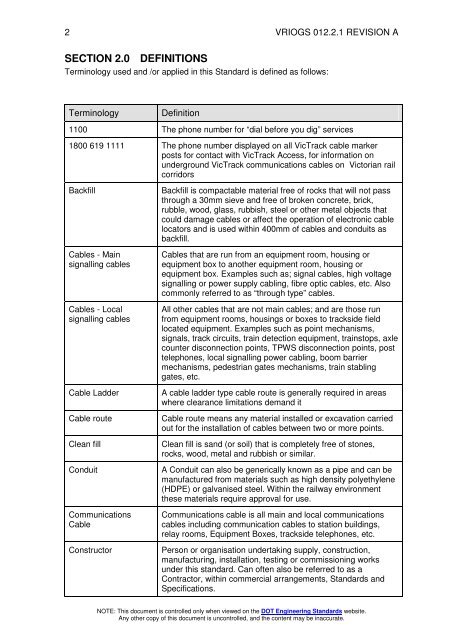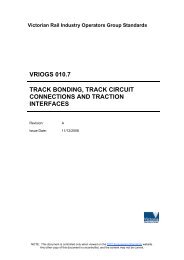VRIOGS 012.2.1 - Public Transport Victoria
VRIOGS 012.2.1 - Public Transport Victoria
VRIOGS 012.2.1 - Public Transport Victoria
You also want an ePaper? Increase the reach of your titles
YUMPU automatically turns print PDFs into web optimized ePapers that Google loves.
2 <strong>VRIOGS</strong> <strong>012.2.1</strong> REVISION A<br />
SECTION 2.0 DEFINITIONS<br />
Terminology used and /or applied in this Standard is defined as follows:<br />
Terminology<br />
Definition<br />
1100 The phone number for “dial before you dig” services<br />
1800 619 1111 The phone number displayed on all VicTrack cable marker<br />
posts for contact with VicTrack Access, for information on<br />
underground VicTrack communications cables on <strong>Victoria</strong>n rail<br />
corridors<br />
Backfill<br />
Cables - Main<br />
signalling cables<br />
Backfill is compactable material free of rocks that will not pass<br />
through a 30mm sieve and free of broken concrete, brick,<br />
rubble, wood, glass, rubbish, steel or other metal objects that<br />
could damage cables or affect the operation of electronic cable<br />
locators and is used within 400mm of cables and conduits as<br />
backfill.<br />
Cables that are run from an equipment room, housing or<br />
equipment box to another equipment room, housing or<br />
equipment box. Examples such as; signal cables, high voltage<br />
signalling or power supply cabling, fibre optic cables, etc. Also<br />
commonly referred to as “through type” cables.<br />
Cables - Local<br />
signalling cables<br />
Cable Ladder<br />
Cable route<br />
Clean fill<br />
Conduit<br />
Communications<br />
Cable<br />
Constructor<br />
All other cables that are not main cables; and are those run<br />
from equipment rooms, housings or boxes to trackside field<br />
located equipment. Examples such as point mechanisms,<br />
signals, track circuits, train detection equipment, trainstops, axle<br />
counter disconnection points, TPWS disconnection points, post<br />
telephones, local signalling power cabling, boom barrier<br />
mechanisms, pedestrian gates mechanisms, train stabling<br />
gates, etc.<br />
A cable ladder type cable route is generally required in areas<br />
where clearance limitations demand it<br />
Cable route means any material installed or excavation carried<br />
out for the installation of cables between two or more points.<br />
Clean fill is sand (or soil) that is completely free of stones,<br />
rocks, wood, metal and rubbish or similar.<br />
A Conduit can also be generically known as a pipe and can be<br />
manufactured from materials such as high density polyethylene<br />
(HDPE) or galvanised steel. Within the railway environment<br />
these materials require approval for use.<br />
Communications cable is all main and local communications<br />
cables including communication cables to station buildings,<br />
relay rooms, Equipment Boxes, trackside telephones, etc.<br />
Person or organisation undertaking supply, construction,<br />
manufacturing, installation, testing or commissioning works<br />
under this standard. Can often also be referred to as a<br />
Contractor, within commercial arrangements, Standards and<br />
Specifications.<br />
NOTE: This document is controlled only when viewed on the DOT Engineering Standards website.<br />
Any other copy of this document is uncontrolled, and the content may be inaccurate.

















